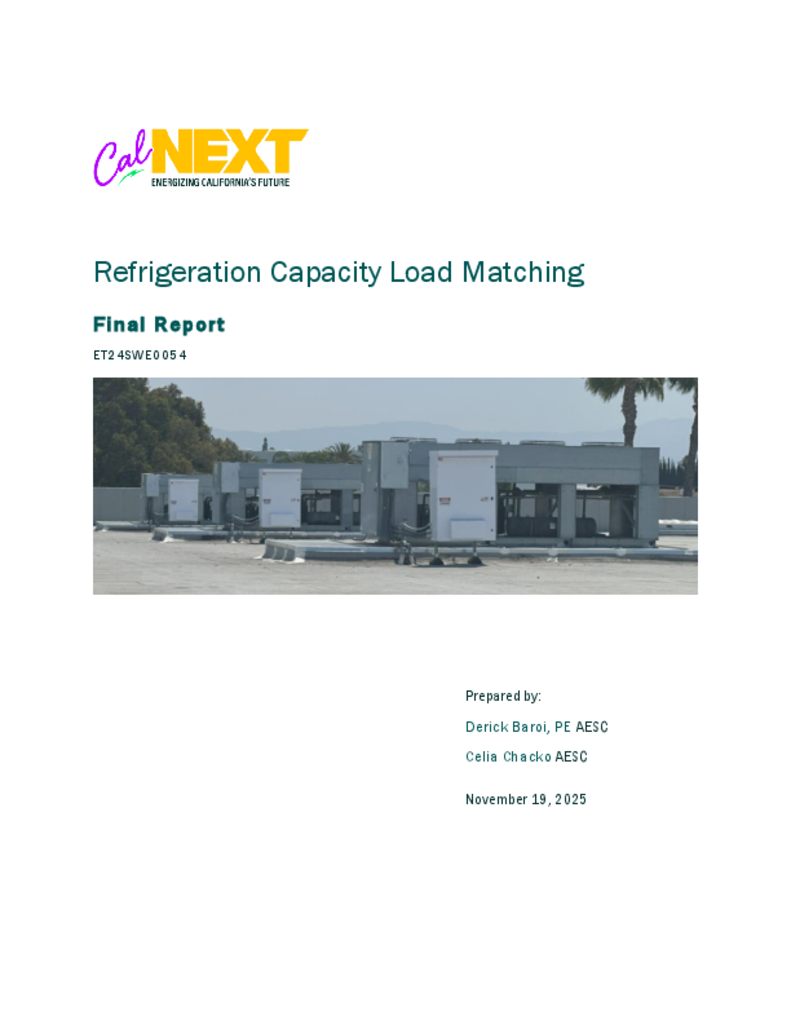ET24SWE0054 - Refrigeration Capacity Load Matching
All existing refrigeration systems operate 24/7/365 and consume vast amounts of energy to maintain the required temperature to prevent spoilage of food, medicine, flowers and industrial chemicals. It is standard practice that all refrigeration systems are designed to maintain temperature even on the hottest day (95F or higher). Each refrigeration system consists of a condenser assembly (compressor, condenser coil and fans) and the evaporator assembly (evaporator, fans and expansion valve controller); the evaporator absorbs heat from the load and the compressor draws that heat and sends it to the condenser which discharges it to the atmosphere. The inherent problem with this system is that the evaporator controller can only sense the load at the evaporator and has no way to pass that information to the compressor and condenser. The evaporator controller will typically see a load that is 40-80% of its full capacity while the compressor is always operating at full capacity which is a system mismatch.
This project introduces a packaged variable refrigerant flow (VRF) system with controls to safely match compressor power with evaporator loads. The benefits of VRF systems are widely accepted and the main feature is VRF systems utilize inverter-driven compressors that adjust refrigerant flow based on real-time needs. By adapting innovative VRF strategies along with new instrumentation and software algorithms to manage refrigerant flow within AC compressors, previous projects have resulted in saving 25-50% energy after retrofit. The package includes a variable frequency drive (VFD) and smart compressor control (SCC) system that continuously manages compressor speed based to match the load. The SCC senses suction and discharge temperature at the compressor and by communicating with the drive to evaluate parameters like torque and kW it safely manages speed within manufacturers’ guidelines. In addition to energy savings the SCC also protects the compressor from single phasing, unequal voltage and short cycling. It also extends compressor life via soft start and less wear.
- The project will install the packaged technology on refrigeration systems that have been monitored by a remote energy monitoring platform in up to 5 locations, targeting in disadvantaged communities (DAC) that may have over 5 years of historical operating data including temperature, run times and compressor amperage.
- Locations may include applications in grocery stores, food processing, food wholesalers, and cold storage facilities.
- By leveraging existing monitoring systems and data, a solid baseline can be developed to calculate the coefficient of performance (COP) of the systems for the analysis prior to installation.
- After installation, the system will be monitored, and data will be collected to understand installation procedures, long-term system performance, maintenance, and operational needs.
- From this project, we will be able to determine cost effectiveness, safety, and best practices of each compressor retrofit. Data from this project could also be used to develop a new energy efficiency measure for CA utilities.
Commercial and industrial refrigeration systems frequently use fixed-speed compressors that operate inefficiently under variable load conditions, contributing to elevated energy consumption and greenhouse gas (GHG) emissions. In California, refrigerated warehouses consume over 2,600 GWh annually, underscoring the need for scalable efficiency solutions aligned with the state’s decarbonization goals.
This study evaluates a retrofit emerging technology (ET) comprising a smart compressor control (SCC) system, a variable frequency drive (VFD), and temperature sensors. Unlike traditional pressure-based modulation, the SCC algorithm dynamically adjusts compressor operation based on suction and discharge temperatures, enabling more precise load matching. Field demonstrations were conducted at two refrigerated produce warehouses located in disadvantaged communities within California Climate Zones 9 and 10. The retrofit included four 40 horsepower (HP) compressors at Site 1 and four 25 HP compressors at Site 2, which were all fixed-speed reciprocating units. Compressor real power, compressor run time, outside air temperature (OAT), and space temperature were monitored during the summer season. Performance was normalized using temperature bins and regression modeling.
Site 1 exhibited consistent improvements, achieving normalized energy savings of 20 percent to 22 percent, peak demand reductions of 25 percent to 30 percent, and annual GHG reductions of 10 to 11 metric tons of CO₂e per compressor. Site 2 yielded mixed results, two compressors demonstrated 12 percent to 22 percent energy savings, peak demand reductions of 5 percent to 7 percent, and annual GHG reductions of 4 to 7 metric tons of CO₂e per compressor, while the other two compressors showed increased energy use due to unadjusted defrost cycles. Simple payback periods ranged from 1.7 to 2.0 years for compressors with positive savings. Although the customer at Site 2 reported pre-existing defrost issues, customers at both sites reported no operational or performance issues after ET installation.
These findings indicate that the ET offers a viable pathway to enhance refrigeration system efficiency and support broader energy and climate policy objectives.

